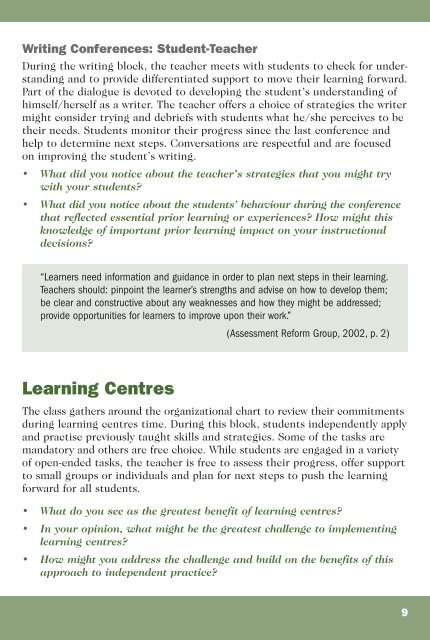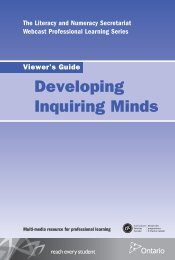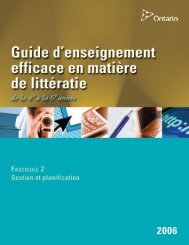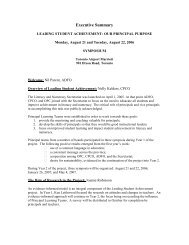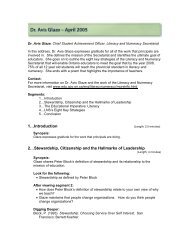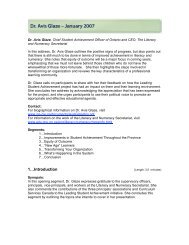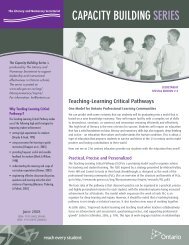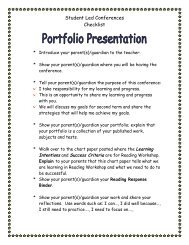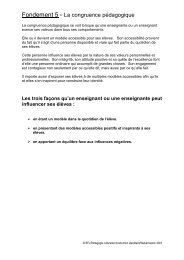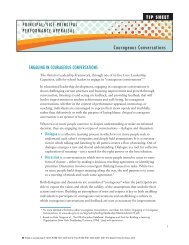Precision Teaching in the Primary Classroom Viewer's Guide
Precision Teaching in the Primary Classroom Viewer's Guide
Precision Teaching in the Primary Classroom Viewer's Guide
- No tags were found...
You also want an ePaper? Increase the reach of your titles
YUMPU automatically turns print PDFs into web optimized ePapers that Google loves.
Writ<strong>in</strong>g Conferences: Student-Teacher<br />
Dur<strong>in</strong>g <strong>the</strong> writ<strong>in</strong>g block, <strong>the</strong> teacher meets with students to check for understand<strong>in</strong>g<br />
and to provide differentiated support to move <strong>the</strong>ir learn<strong>in</strong>g forward.<br />
Part of <strong>the</strong> dialogue is devoted to develop<strong>in</strong>g <strong>the</strong> student’s understand<strong>in</strong>g of<br />
himself/herself as a writer. The teacher offers a choice of strategies <strong>the</strong> writer<br />
might consider try<strong>in</strong>g and debriefs with students what he/she perceives to be<br />
<strong>the</strong>ir needs. Students monitor <strong>the</strong>ir progress s<strong>in</strong>ce <strong>the</strong> last conference and<br />
help to determ<strong>in</strong>e next steps. Conversations are respectful and are focused<br />
on improv<strong>in</strong>g <strong>the</strong> student’s writ<strong>in</strong>g.<br />
• What did you notice about <strong>the</strong> teacher’s strategies that you might try<br />
with your students<br />
• What did you notice about <strong>the</strong> students’ behaviour dur<strong>in</strong>g <strong>the</strong> conference<br />
that reflected essential prior learn<strong>in</strong>g or experiences How might this<br />
knowledge of important prior learn<strong>in</strong>g impact on your <strong>in</strong>structional<br />
decisions<br />
“Learners need <strong>in</strong>formation and guidance <strong>in</strong> order to plan next steps <strong>in</strong> <strong>the</strong>ir learn<strong>in</strong>g.<br />
Teachers should: p<strong>in</strong>po<strong>in</strong>t <strong>the</strong> learner’s strengths and advise on how to develop <strong>the</strong>m;<br />
be clear and constructive about any weaknesses and how <strong>the</strong>y might be addressed;<br />
provide opportunities for learners to improve upon <strong>the</strong>ir work.”<br />
(Assessment Reform Group, 2002, p. 2)<br />
Learn<strong>in</strong>g Centres<br />
The class ga<strong>the</strong>rs around <strong>the</strong> organizational chart to review <strong>the</strong>ir commitments<br />
dur<strong>in</strong>g learn<strong>in</strong>g centres time. Dur<strong>in</strong>g this block, students <strong>in</strong>dependently apply<br />
and practise previously taught skills and strategies. Some of <strong>the</strong> tasks are<br />
mandatory and o<strong>the</strong>rs are free choice. While students are engaged <strong>in</strong> a variety<br />
of open-ended tasks, <strong>the</strong> teacher is free to assess <strong>the</strong>ir progress, offer support<br />
to small groups or <strong>in</strong>dividuals and plan for next steps to push <strong>the</strong> learn<strong>in</strong>g<br />
forward for all students.<br />
• What do you see as <strong>the</strong> greatest benefit of learn<strong>in</strong>g centres<br />
• In your op<strong>in</strong>ion, what might be <strong>the</strong> greatest challenge to implement<strong>in</strong>g<br />
learn<strong>in</strong>g centres<br />
• How might you address <strong>the</strong> challenge and build on <strong>the</strong> benefits of this<br />
approach to <strong>in</strong>dependent practice<br />
9


